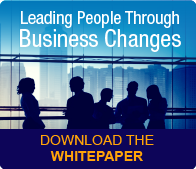One of the common questions that comes up in our change management consulting work is why the organizational climate for transformational change matters. The reason why you need to fully understand your organization's current climate is simply because that is the environment in which you will be implementing the transformation. In common language, "It is what it is." 
Sponsors often under-estimate what is required to actually implement transformational change. The hard work of designing a change is miniscule in comparison to what it takes to implement the change!
Now more than ever, organizations have a number of strategic business changes that are occurring simultaneously. We repeatedly tell change management consulting clients that implementation is a ferocious, resource-consuming activity. The cumulative nature of these changes is significant:
- Change leads to disruption, and to stress. The greater the stress, the higher the likelihood of implementation failure, and the greater the need for a structured approach
- Stress and disruption are cumulative over time
To illustrate this point, think of your senior executive sponsors as the "big wheel" at the top. Each time the senior leaders launch a new strategy from on high, the "little wheels" of the organization start churning madly as plans for implementation move forward.
Because it take much more in terms of time, energy, and resources to actually implement, the little wheels are moving at a frenetic pace when the next change gets launched from the top. The end result is that the little wheels just can't absorb all of these changes because the stress and disruption are cumulative.
Remember, no change occurs in isolation, it occurs in the context of all the other changes going on in the organization at the same time, and the organization's past history.
A client that is deep into transformational change mentioned recently that their organization currently has literally thousands of projects that are under their transformation program. Imagine how those little wheels are turning at the middle levels of the organization!
Specifically, there are six reasons why you would want to conduct a climate assessment, using AIM (Accelerating Implementation Methodology) measurement diagnostic tools like our Implementation History Assessment (IHA) or Organizational Stress Test:
- To estimate the degree of difficulty you will face in implementing the transformational change
- To determine the amount of effort and investment that will be needed. What is the resource load that will be required to overcome your systemic weaknesses?
- To predict the points of resistance
- To enable you to form strategies to manage the resistance
- To develop awareness of your climate in your Sponsors and Change Agents-- much like a thermometer
- To assess other events going on in the organization
The more understanding you have of your systemic weaknesses and the degree of disruption your changes are having, the more control you can bring to the implementation through appropriate application of mitigating strategies and tactics. What is often overlooked is that disruption, not negative change, is the predictor of stress and of resistance. Highly disruptive positive changes will generate resistance, too.
To avoid having your transformational change slow down, stall out, or fail to deliver the anticipated value realization, avoid these common speed bumps:
- Believing "this time will be different"
- Thinking that your implementation is the only project going on in the organization
- Having too many priorities diffuse focus, and resources
- Reinforcing a risk-averse culture that reduces the organization's capacity to learn from its past
- Ignoring specific implementation history data, and not planning specific strategies to overcome systemic weaknesses
There is a lot of talk about creating readiness for transformational change. If you have greater awareness and understanding of your history and organizational climate, and you have a structured framework, you will be much better positioned for identifying the right tactics and strategies to increase change readiness, and drive value realization.


